by Roger L. Papke, Handfuls of History
At the end of the American Civil War, the Union had well over a million surplus muzzle-loading rifle-muskets, all of which were obsolete since it was clear that in the future all military rifles would be breech-loaders and most likely use metal cartridges. The U.S. was not alone in this predicament; most European nations were in the same boat. Prior to the end of the American Civil war, only Prussia had standardized on breech-loading bolt-action rifles, albeit with paper cartridges and needle-fire ignition. France was committed to an arms race with Prussia, and having seen Prussia overcome Austria in the Austro-Prussian War, France also introduced their own bolt-action needle-fire Chassepot rifles in 1866.
The U.S., England, and Austria found an economically effective solution out of their firearm crisis. They adopted methods to convert muzzle-loaders to breech-loaders, allowing the reuse of existing stocks of muskets and associated spare or surplus parts. The English used the Snider conversion system on their pattern 1853 Enfields, and the Austrians produced Wanzl conversions for their Lorenz rifles. However, both the Snider and Wanzls were stop-gap solutions, soon to be replaced by new models, Martini-Henrys in Great Britain and Werndls in Austria. Only in the U.S. did the conversion models lead to the long-term production of similar new rifles.
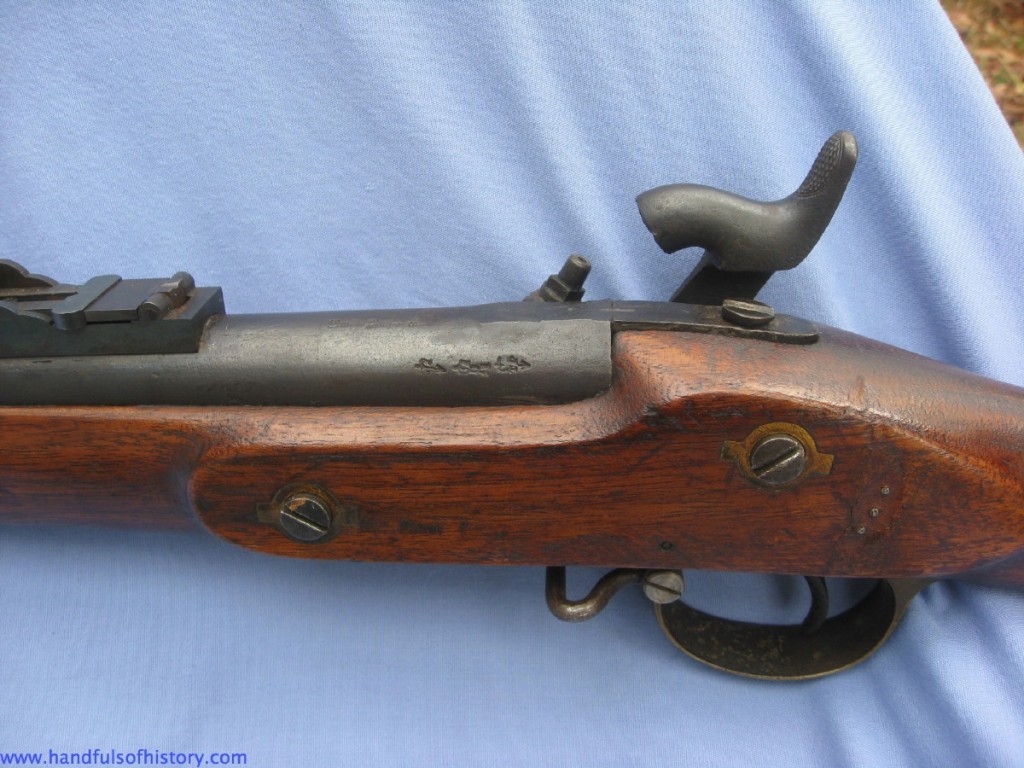
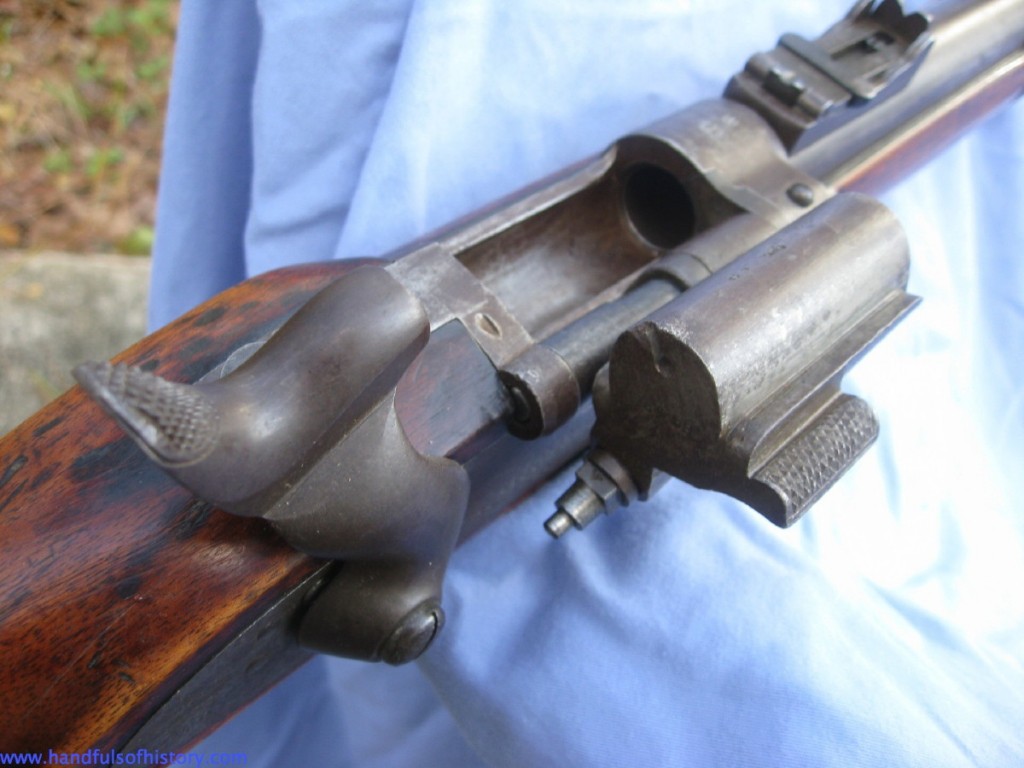
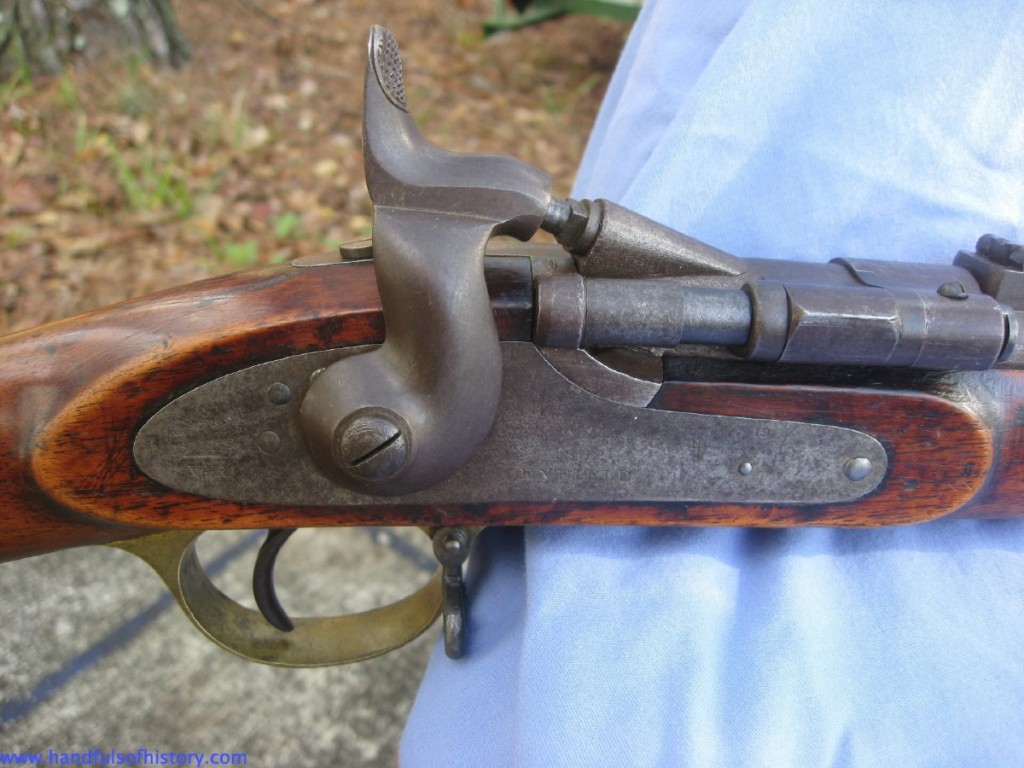
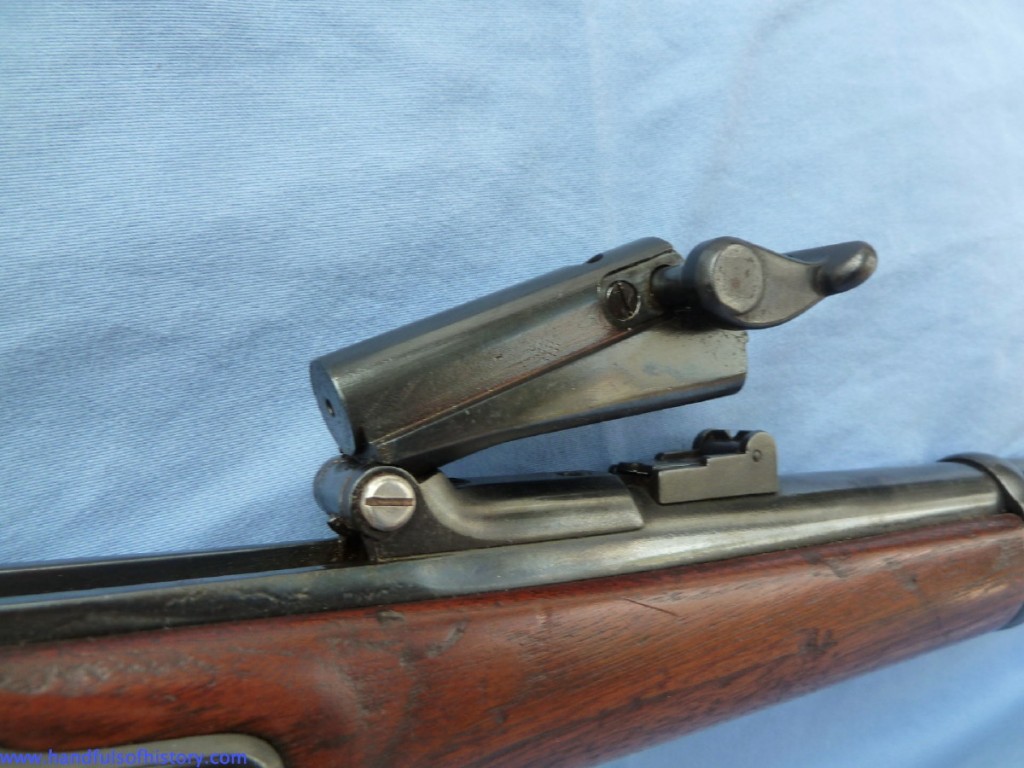
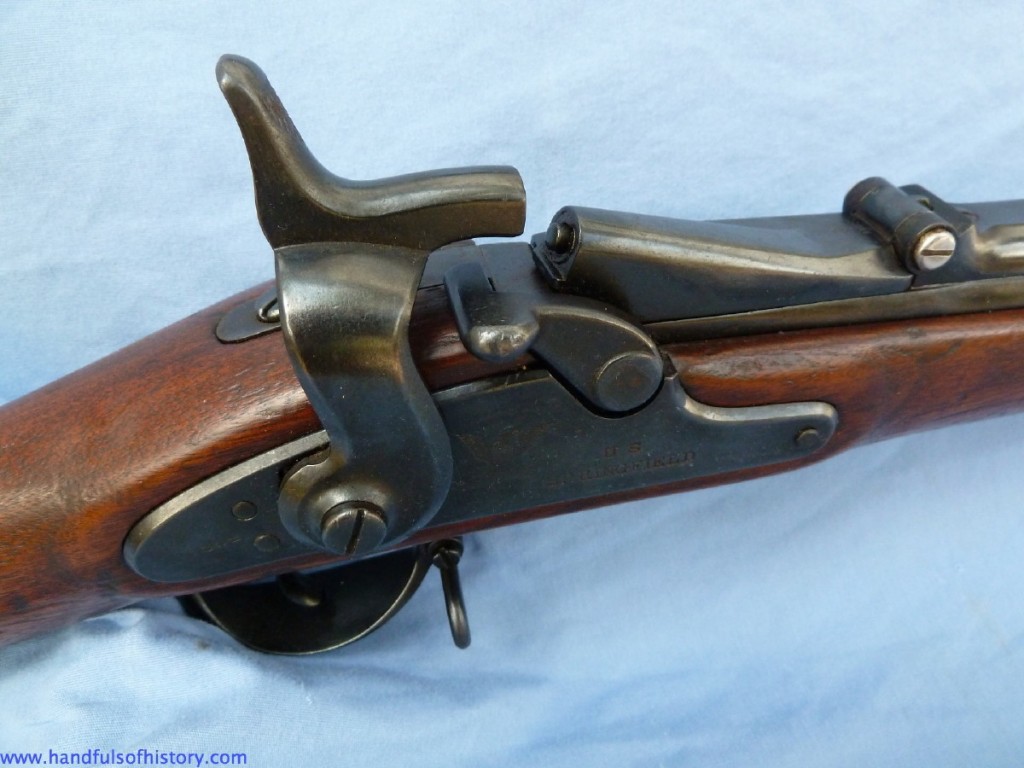
Reportedly, several conversion systems were considered by the U.S. Army, including Rolling Block and Peabody mechanisms. However, I suspect that the “trapdoor” system designed by Springfield Master Armorer Erskine S. Allin always had the inside track on the U.S. trials. One alternative conversion system, which apparently was given only passing consideration, was designed by two brothers, Joseph and George Henry Needham of London, England. The rifle shown is a Needham converted rifle.
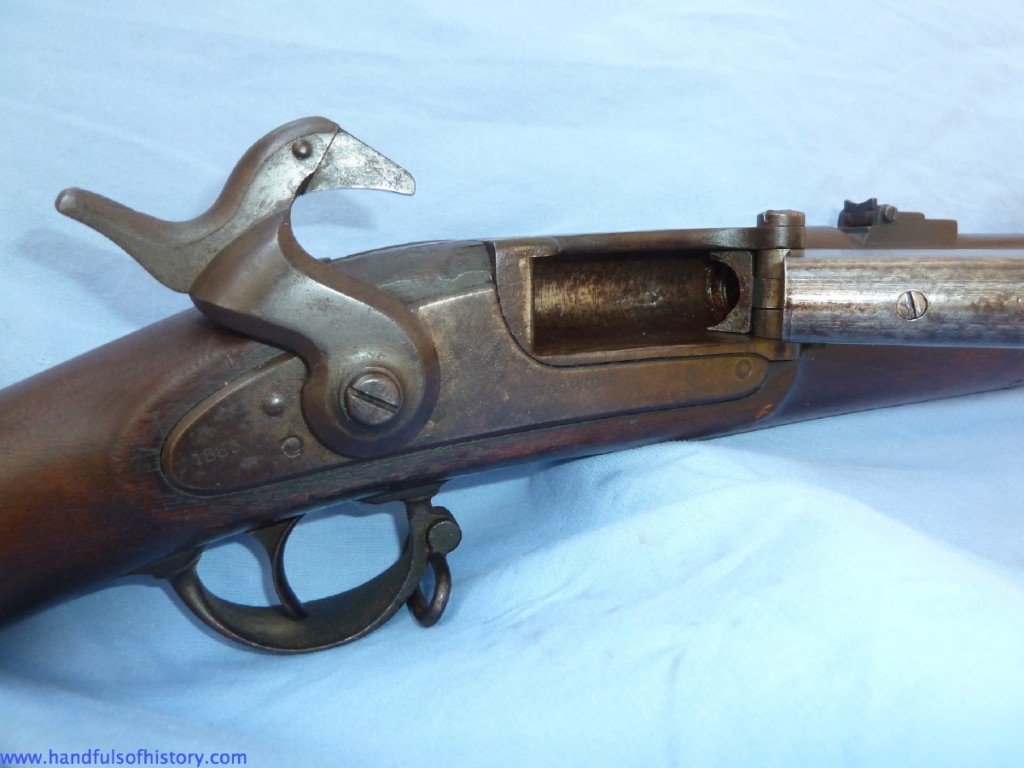
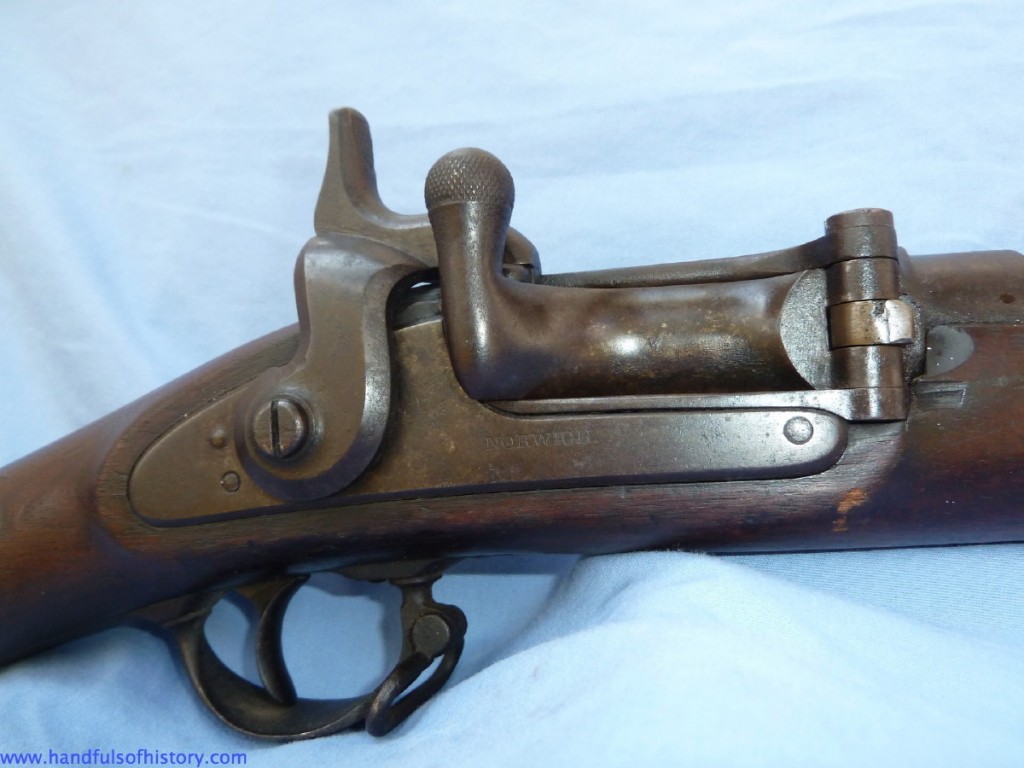
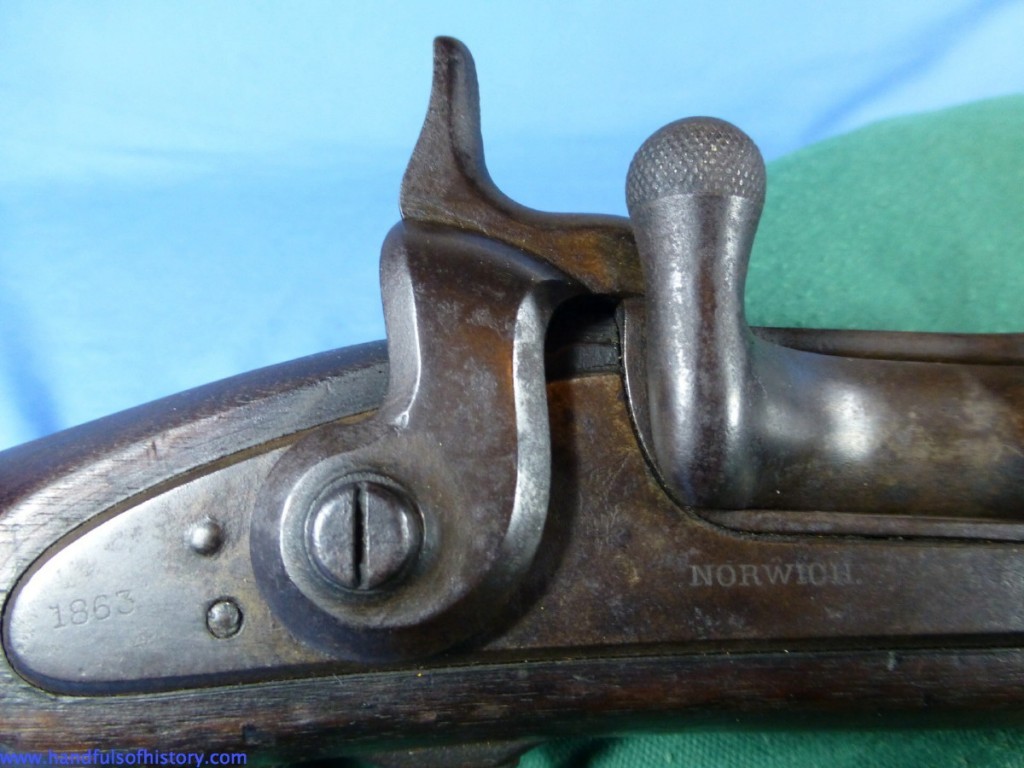
The Needham conversions were probably pretty cost effective, but the early models in particular had problems which I discovered after I obtained this example. As with any conversion the first step would have been to cut into the original sealed chamber, opening up a breech. A new chamber would have to be milled into the end of the barrel to accept a metal cartridge of the type pictured. Then a hinged breech block would be installed with a firing pin and transfer bar that could be hit with the hammer which had been modified to reach into a recess in the block. A spring was installed to pull back the pin before and after the moment when the transfer bar extension of the firing pin was struck by the hammer. On the early models, the firing pin transfer bar casting was liable to break, as occurred with this rifle. Loosening a set screw allowed the remnant of firing pin to be removed, revealing that it had broken at the point where the transfer bar once connected.
I was delighted (and frankly amazed), to discover that The Rifle Shoppe in Jones Oklahoma had listed in their catalog both “old style” and “new style” firing pins for Needham conversions! However these were not items that they had on the shelf but rather an ability to cast upon order. The waiting list was considerable, but after about 10 months I received the two casting shown in the picture with the broken original. I ordered both because at that time I did know not which was the right part for my gun. I had been in touch with Jim Burgess who had co-authored a report on Needham conversions with Marc Gorelick which was presented to the Virginia Gun Collectors Association and available on-line*. Jim had sent me a sketch of the firing pin from his gun, and it was clearly unlike mine, so I knew different versions existed.
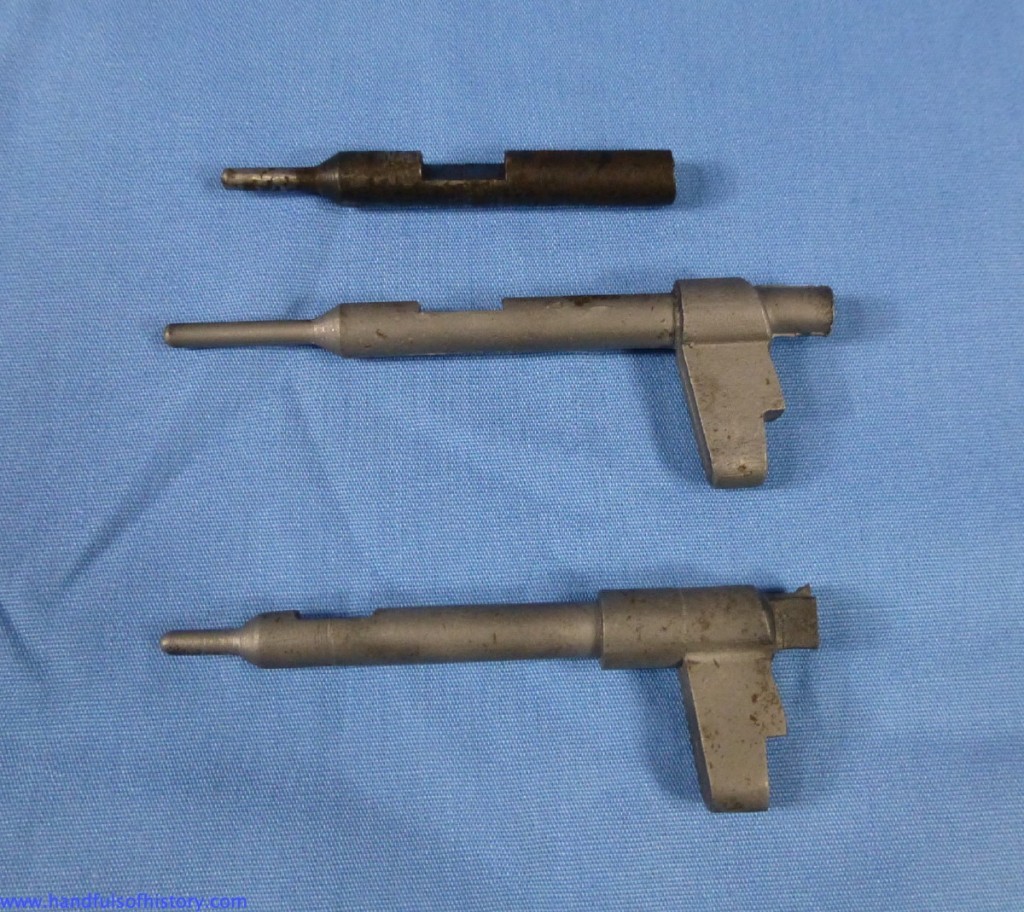
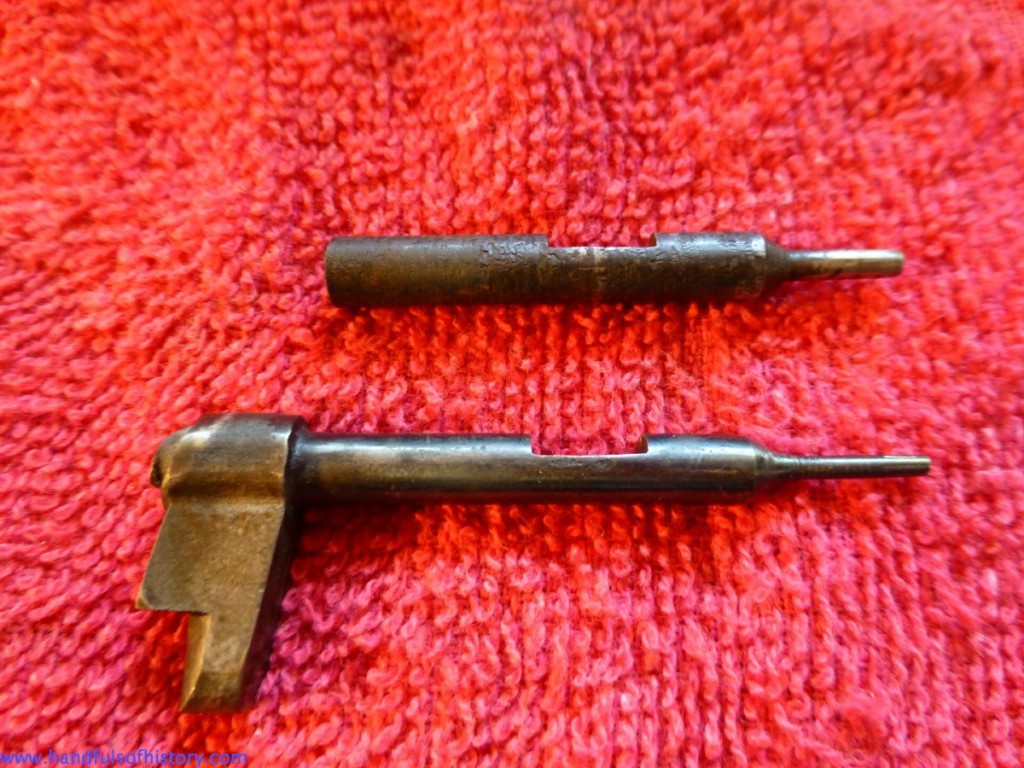
As can be seen in the picture, when I compared the broken pin to the two castings, it was apparent which was a match for mine; however, it was also apparent that the new piece was a rough casting with much more metal than would ever fit in the housing on my rifle. My blacksmith friend Steve Bloom (Iron Flower Forge) did the hand fitting to produce the finished replacement shown. There are several differences between the two styles of firing pins, and clearly they were never intended to be interchangeable. The most important difference is the new style pin is reinforced at the stop where my pin broke. The old style pin is one factor that suggests that this rifle is a very early sample of a Needham conversion, perhaps an example that led to its failure in U.S. government tests. The other factor is that the conversion was built into a rifle made by the Norwich Arms Co., one of the smaller contractors to the Union during the Civil War. The large majority of Needham conversions were built into rifles made by the Alfred Jenks & Sons firm in Bridesburg, Pennsylvania, and so are marked “Bridesburg” on the lock plate.
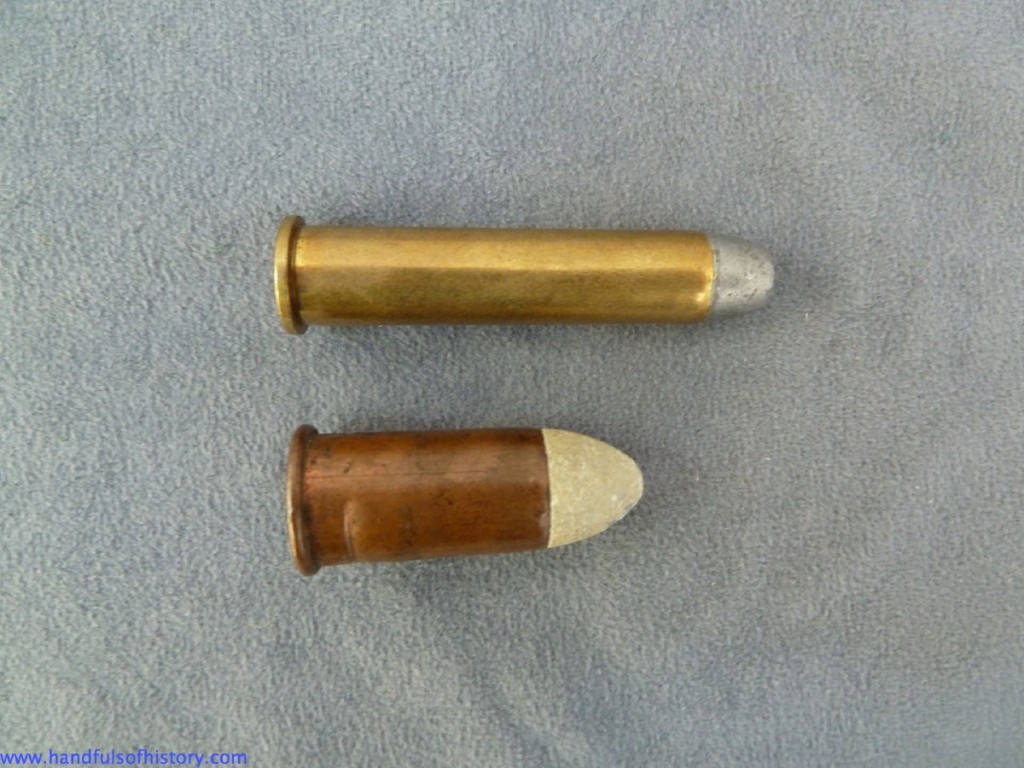
Bridesburg Needham conversions and the Fenian invasions of Canada
The Fenians were an Irish-American group who wanted to put pressure on Great Britain to free Ireland. They conspired to mount an invasion of Canada and occupy some territory in order to force concessions. The Fenians purchased surplus Bridesburg rifle-muskets and sent 600 armed men across the Canadian border from New York in June 1866. The small force briefly captured Fort Erie, but was readily overcome, and the men were sent back to the U.S.. Surprisingly, the Fenians were sufficiently well connected politically that they were able to recover their guns along with their freedom to try again.
However, by the time the Fenians were considering a second foray across the border in 1867, the British troops in Canada were equipped with Snider conversions of the P1853 Enfield rifle, and the Fenians knew they would be seriously outmatched with their original muzzle-loading Bridesburg muskets. Reportedly, supporters of the Fenians rented space in a Trenton, New Jersey shop, where hired English gunsmiths performed the Needham conversions on about 5,000 rifle-muskets. The Fenians launched a second invasion in May of 1870 across the Vermont border. The Canadians were forewarned and the Fenians soundly defeated. This time, the guns used in the attack were confiscated by the U.S. Army, along with additional guns that had been stored in Trenton. The army subsequently auctioned off the guns, a large number of which were purchased by the surplus dealer Schuyler, Hartley & Graham. These guns account for the majority of the Needham convertion rifles which occasionally show up for sale.
References

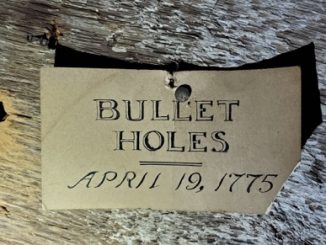
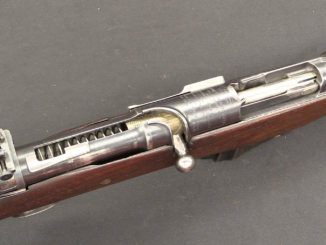

How does the side door lock closed? Is it just the striker on the hammer and then hinge tension when the hammer is back?
http://www.shilohrelics.com/cgi-bin/Display_Item.asp?100775
Few more pictures there, looks like the door just “jams” shut, then the hammer locks it, by blocking it’s movement when it falls.
Pretty good really, simple.
The hammers striker must jam the door shut sufficiently prior to striking the primer…
Perfect timing. I just was writing about the Lorenz this week, looking at a beat-up Snider I brought back from Afghanistan, and thinking, “you know, everybody worldwide seemed to go through a brief phase of converting muzzle-loaders…”
My Afghan Snider was reconverted, by some desert Bubba, to percussion breechloader. In place of the firing pin, there’s a nipple for a cap. I can’t imagine this al-Bubba job was reliable.
Quite a good idea though probably, more ammunition flexibility.
England was a real hotbed of conversions in the 1860s. Allin-type “trapdoors’ and breechblocks that swung out to the side like the Needham seem to have been the most popular, with bolt-actions running a close third.
Several of the “trapdoor’s” were based on a patent owned by someone name “Storm”. I’m wondering if this wasn’t William Montgomery Storm, an American inventor of the time more noted over here for his work on revolvers. He had a tendency to sign his name “Wm. Mont. Storm”, or “Montstorm” , which often leads modern researchers to “miss” some of his work because it’s filed under “M” instead of “S”.
Needham later came up with one of the odder repeating rifles of the era. Lever-operated, tube-magazine, with Thuer Colt-type cartridges and a two-chambered flipover “loading block” breech like a “Bar” pistol;
http://i248.photobucket.com/albums/gg196/hfcable/atkinsonneedham2.jpg
Very strange.
cheers
eon
Groovy gun, nice Moose he he
Eon,
I have a Needham (one of the Fenian conversions) sitting alongside my Sniders and Trapdoors. I knew the story behind it when I acquired it about 25 years ago. As for William Montgomery Storm, he did do a conversion of the Springfield, but according to Flaydermann, they are quite rare. I haven’t seen one in person. One of Storm’s most interesting designs was a fire-extinguishing gun that used a percussion charge to launch a brick of sodium bicarbonate into a burning fire and to extinguish it by removing the oxygen in the immediate area. A local dealer had one in his personal collection, and it looked like a large, brass-framed percussion blunderbuss. He would bet his customers that they couldn’t guess what it was. I’d read about them before I saw his, and he had to fork over $100.00 when I correctly identified it. He had some cool stuff and got his money back along with a good bit of mine. Fun times!
Do you still have your Needham?
The Fenian connection is particularly interesting and not one that I was aware of. I assume the guns they got back were ones that were not captured in Canada, but rather ones that were temporarily confiscated from them by the US government when they retreated back to the US.
The Fenians were one of several different unrelated terrorist and insurgent groups who operated openly from US bases and attacked Canada over the course of the 19th century. The US government would turn a blind eye to them until after they had failed and then go through the motions of banning them in order to show that they had no “official” involvement. Cross border insurgencies as a form of limited warfare aren’t really that new of a thing. Given the above, that the Fenians were able to get their weaponry back in order to make another attempt is not that surprising.
The Fenian connections of the Needham conversion make it of historical interest, and not just a technological oddity. That is something that should be very useful for a collector to know.
Is there some way of telling if a particular Needham conversion was used by the Fenians?
On the level of firearms – a very interesting article. Proves how after a conflict, of which many produced the “next level” of technology, – militaries look for ways to utilize surplus arms as budgets are severely stressed once the fighting is done.
On a personal level – those pesky Irish!! ;-D I also wasn’t aware of the Canada forays by the Fenians. My Great-Grandfather came to America in the 1870s. Family legend has it due to “political” reasons. Or it could have been he was the youngest of 5 sons and there wasn’t much hope for a life on a small piece of land. Yet family historians have verified two of his brothers were hung for gun running. And I remember my Grandmother saying many times “Joe-Pa was a Fenian.” A picture exists somewhere of the Sein Fein Cabinet during the Easter Rising of 1916 and a distant cousin is in the 3rd row. I’ve seen it a few times but its been lost. Being raised in an American family with Irish Republican leanings proves to me the adage “one man’s terrorist is another man’s freedom fighter.” – a saying that is very sorely tested today.
Aye it was fascinating about the Fenian’s, I have heard the term before in relation to 19th c anarchists amongst over things but I was unaware of this particularly escapade.
It would be good to have a Fenian Needham for sure, for historic interest.
I lived in the 26 counties for the best part of a decade, and the only Irish anarchist I know are a handful of Rothbardians (libertarian anarchists), and I only found them after I’d left the island.
The various modern day splinter of the feinian movement were overtly populist democratic republicans (Fienne Fail) Christian democrat (Fiana Gael) and social democrat / national socialist (Sinn Fein).
Although medieval Ireland was arguably a highly decentralized system (with about 200 “kings” at any one time)and a customary and polycentric law system (the “Brehon”).
I don’t know of any references to anarchist influences in the 19th and 20th century Fenian movements.
Peter the Painter…
Muzzle-loaders and their conversions are not normally interesting to me. But that last bit at the end of the article about the Fenians made it all worth while. Here is yet again ANOTHER piece of American history public school decided to not mention. Thank you for illuminating me about them.
I never knew that there was an invasion of Canada launched from us soil by Irish immigrants. that is why I love forgotten weapons. Even when I don’t care at all about the gun in question I still seem to learn about something that does interest me.
The Fenian raids have always been interesting to me. It was my understanding that the 1870 raiders were armed with Allin-system trapdoors. Now I find this fascinating article! Excellent stuff!
Incidentally, it turned out it wasn’t British Sniders the Fenians had to fear. When they crossed into Quebec from Vermont, they were met with accurate fire delivered by Canadian militiamen armed with Ballard rifles. These gentlemen had heard about the Fenian threat long before, and had tasked their more firearm-savvy neighbors with choosing a rifle to arm themselves with. They chose well – the Fenians were chased off never to return.
The Fenians were uniformed for this raid, in green cavalry-style shell jackets with gold trim and buttons embossed with the initials “IRA” – the first known use of the term.
Never heard of Fenians invasion of Canada. They had made wrong assumption apparently. Canadians and before them British had plenty of previous experience with American incursions.
Regarding conversions – this is good subject and one of those key moments in long guns development. Next we gonna see conversion of existing rifles to caseless (by converting metal cases to combustible ones)…:-)
technology regressing 150 years
😛
I’m a big fan of the orphaned computer war game, “Age of Rifles”. One of the available scenarios was a Fenian invasion of Canada from New York. I don’t know if these conversions played any role in the design of the scenario, but it’s certainly an entertaining one.
That game looks good Chris, it reminds me of a book I had as a kid… Knights at war “loved that book” it had games you could cut out, hexagonal layout sort of thing… I’ve never really been into computer games since Hunter on my Atari St, loved that game, seagulls, wander around doing your own thing, help yourself to a boat etc. Quite liked Gun on Ps2 Cowboy thing, these modern ones have to many controls for me no patience, keep getting killed, I sold my Ps3 in about a week as a consequence he he.
Hey I found it!
http://boardgamegeek.com/boardgame/7558/battlegame-book-2-knights-war
Just came back to me, after seeing pictures of age of rifles.
Invading Canada does get short mention thesey days. Benedict Arnold comes to mind.
Just for the record Florida, Mexico, South America all s’enjoyed private invasion attempts, some successful for a time.
Later wisdom involved “send the marines.”
The conversion period is fascinating for it’s variety. Had never heard of Needham conversion.
I can’t believe you actually got something from the Rifle Shoppe!
Did I get it right about the rifled muskets?
I always thought muskets were smooth bore.
Regards, Andrzej
I have one–in very good condition. I would not fire it even if I had ammunition!!
What has been left out from this exchange is that the initial
raid on Canada was set up by General Grant to get the British to pay
up for the so-called Alabama claims during our Civil War. Worked, too.
Were all Needham conversions done by the Fenians? I have a Bridesburg Needham without the IR stock stamping.
All the Needhams that were built before the 1870 raid were built by the Fenians. After the raid, all the completed Neddhams the U.S. could find were confiscated iincluding the completed, uncompleted, and parts that were found at Pioneer Arms Works. SH&G bought all the guns including the uncompleted ones and parts that were found at P.A.W. SH&G then took the parts and put together as many Needham as they could from the uncompleted ones and the parts. SH&G then sold all them. There were approximately 1500 sold by SH&G. It is not really known how to tell the difference between Fenian built abd a SH&G built. I have 8 Needham Conversions. Their were Needhams found at the battlefield and in crates the Fenians sent out to the Canadian border that had the IN or R or cut or all three and there were also some found that had none.
Can anyone tell me about a trenton 1864 stamped rifle with snider conversion, were these used by Fenians or elsewhere,
Thanks
Ron
Can anyone tell me where ammunition for the Needham 58 caliber could be found? or components.
Fenian Needham conversions can be identified by two piece stocks. The finished rifles were disassembled for shipment so that it would not be obvious the crates contained rifles. The stocks were carefully cut in a “ V “ configuration under the first barrel band. The stocks now became 2 piece with the clamp band holding them together. My rifle shoots quite well with a 24 gauge brass shotgun shell, 20 grains trail boss powder, a fiber wad and a .600 500 gr. Plus bullet by Acurite Molds.
The most common v-cut was under the middle band.
Do you still have your Needham? I run a website called Pioneer Arms Works that excusively features the Needham Conversion. I would like to ask you some questions about yours if you are willing.
Thanks
Robert Morris
rsm6120@protonmail.com
https://www.pioneerarmsworks.com
I have a question, the article says the Norwich Needham is an early one. What is it about that one that says it is early?